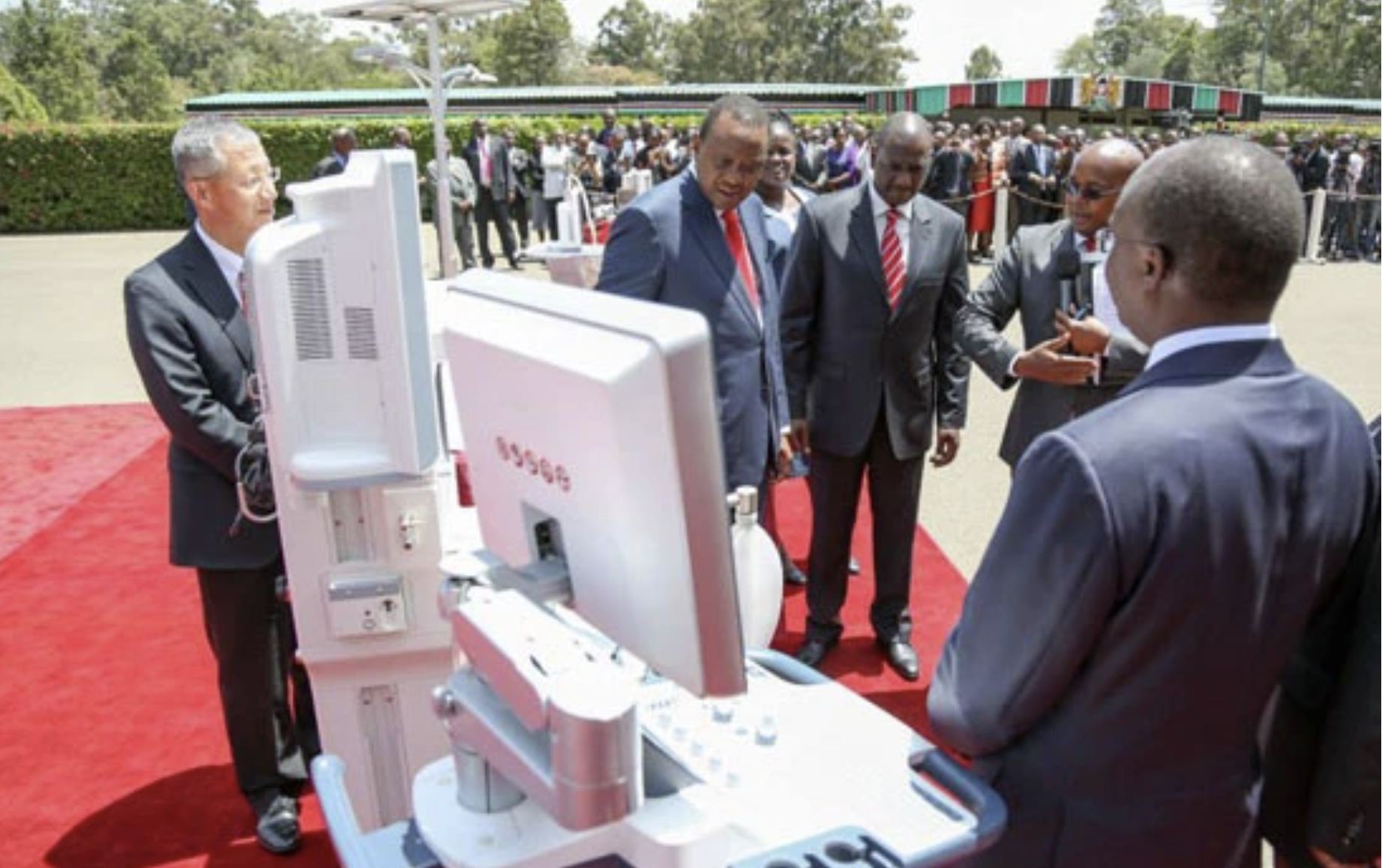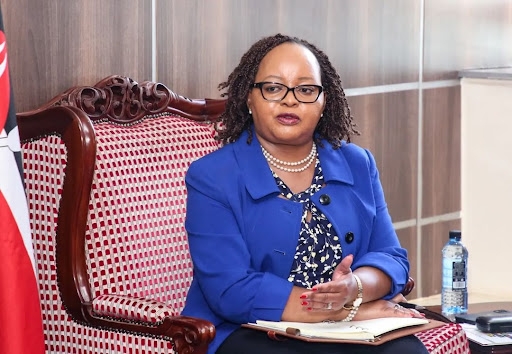 The then President Uhuru Kenyatta and Deputy President William Ruto receive medical equipment procured through the Managed Equipment Services (MES) Project at State House, Nairobi on February 6, 2015. Also present was then Health Cabinet Secretary James Macharia, Director of Medical Services Dr Nicholas Muraguri and Cheng Minghe of Mindray Megascope Health Care.
The then President Uhuru Kenyatta and Deputy President William Ruto receive medical equipment procured through the Managed Equipment Services (MES) Project at State House, Nairobi on February 6, 2015. Also present was then Health Cabinet Secretary James Macharia, Director of Medical Services Dr Nicholas Muraguri and Cheng Minghe of Mindray Megascope Health Care.In early 2016, staff at the Thika Level 5 Hospital watched in awe as a CT Scan machine whirred to life for the first time inside the hospital.
Patients no longer needed to seek such services in private facilities. Similar scenes unfolded across the country. This was the Managed Equipment Services (MES) programme, Kenya’s Sh63 billion public-private partnership launched in 2015.
Now, for the first time, architects of MES have published an exhaustive review of the project, explaining how the project was crafted, and why they firmly believe it was transformative despite widespread opposition.
They are Dr Nicholas Muraguri, who was then Principal Secretary for Health, radiologist Dr Laban Thiga, Dr Ephantus Njagi of the University of Nairobi, biomedical engineer Dr Kenneth Iloka, and Sasha Wawira of the University of Glasgow.
Dr Muraguri and colleagues said MES was noble but was politicised. It also faced opposition because there was no full involvement of stakeholders such as MPs and governors.
“The Kenyan experience suggests that proactive engagement—where stakeholders' concerns are addressed through transparent communication—can enhance buy-in and minimise opposition,” they said in the recent review published by Frontiers in Health Services journal.
In 2020, a Senate Ad Hoc Committee branded the MES a
“criminal enterprise.” The committee accused government officials of signing
opaque contracts and deducting county funds without consent.
The committee claimed that the government had paid billions for equipment that was overpriced or never delivered. The report recommended that the individuals involved be prosecuted.
However, the Senate later voted to reject the report, reportedly under political pressure. The controversy only deepened public mistrust.
Dr Muraguri and colleagues advise that future implementation
of such projects should involve multiple government agencies, healthcare
providers, private contractors, and surrounding communities. Still, that does
not guarantee a smooth running.
"While broad participation enhances project acceptance and ensures smoother execution, it can also introduce complexities. Diverse interests may lead to differing views and conflicts, delays, or resistance to change,” they say in a review titled "Learning from the Kenyan experiment: key takeaways for implementing managed equipment services in developing countries."
MES was introduced by the former President Uhuru Kenyatta’s
government to fix a longstanding challenge: the lack of modern medical
equipment in Kenya’s 47 counties. From dialysis to ICU care, the project aimed
to democratise specialised services by equipping 98 hospitals - two in each
county and four national referral hospitals – with fully functional imaging,
surgical, sterilisation, and critical care infrastructure.
The Ministry of Health called bids from medical equipment firms to lease equipment on behalf of 47 counties.
Thirty bids were received, and only five were successful. They are General Electric from the US, Philips from the Netherlands, Bellco SGL from Italy, Esteem from India and Mindray Biomedical of China.
These firms would supply, install, train users and offer maintenance and repairs of the medical equipment for seven years.
More than 8,600 pieces of equipment were deployed. New
theatre complexes, mammography machines, mobile x-rays, and digital ultrasound
units began appearing across previously underserved regions.
Controversy came from the money the counties were paying for the services.
Initially, each county government paid Sh95 million annually for the services. This amount increased to Sh200 million annually in the 2018/19 financial year before reducing to Sh131 million in the following years.
“Although the MES arrangement has the potential to significantly enhance healthcare services, particularly in low- and middle-income nations,” Dr Muraguri’s team says, “its implementation is inherently complex, requiring strong governance, a highly skilled multidisciplinary team, and meticulous planning to navigate logistical, financial, and operational challenges.”
Another glaring hurdle was poor infrastructure. The MES contract set a contractual timeframe of one year to commission the 98 hospitals.
However, multiple delays occurred because most hospital buildings were simply unfit for high-end equipment. “The hospitals’ buildings were old with architecture and the in-place electrical, ventilation, air conditioning, and plumbing systems needing to be fixed to accommodate the installation of modern equipment,” they report. In 13 percent of hospitals, entirely new buildings were needed for diagnostic imaging. Any task completed after the agreed one year was categorised as delayed.
“Radiology services were fully implemented by December 2016, with a seven-month delay, while ICU completion was achieved in February 2017, nine months behind schedule,” the report states. Dialysis services, perhaps the most transformative of all, were completed in December 2017, that is, 19 months late.
Inadequate pre-bid hospital assessments were also a key culprit. Contractors underestimated the scale of renovations required, causing huge cost overruns. “The government was unable to cover the additional renovation costs,” the authors explain. “It is recommended to include an architect in the hospital’s assessment prior to the MES design phase.”
The MES contracts were comprehensive as they even included penalties for late installations. But they left out something surprisingly basic: consumables. The PS and colleagues are frank about it. “Interruptions of services continued to occur due to frequent stock-out of essential consumables, leading to patients being unable to access required services. Therefore, in hindsight, we recommend bundling consumables with other MES services.”
Lack of skilled personnel was another serious flaw. Equipment landed, but often there was no one to use it. “Only 25 radiologists were available in 25.6 per cent of MES-targeted hospitals,” the authors reveal. In some hospitals, imaging equipment sat idle because the facility lacked three-phase power.
The shortage of ICU and dialysis nurses forced the government into quick improvisation. “ICU and renal nurses’ training had yet to be prioritised, leading to a limited pool of nurses available for deployment,” the report notes. The solution? A crash four-month specialised training course for general nurses. But this was never sustainable. “Future MES arrangements should include workforce planning, structured personnel training, and funding mechanisms for human resource development.”
Behind the scenes, MES faced another kind of challenge - politics.
Governors suggested that the project was pushed down their throats. They even claimed the Health ministry did not conduct needs assessment before authorising the deployment of the equipment.
“The lack of a clear engagement strategy contributed to misunderstandings about the complexity and cost structure of MES, fuelling perceptions of inadequate value for money and leading to its politicisation,” the study acknowledges. “Future MES projects should incorporate comprehensive stakeholder mapping and proactive engagement strategies to ensure sustained support, address concerns early, and minimise political resistance.”
Despite the many missteps, the MES model, if improved, still holds promise. Similar arrangements have shown success in other parts of the world. “Research from MES projects in high-income countries suggests that outsourcing medical equipment management can yield cost savings of five per cent to ten per cent compared to public-sector-managed procurement,” the authors note.
The MES lease ended in May 2022 but was extended for a few months. It was rebranded the National Equipment Support to Counties (NESC) early last year, with a promise that counties would not pay more. Payments would be made by patients based on services rendered under the Fee-for-Service (FFS) model.
Dr Muraguri and colleagues offer a clear roadmap for future projects. Comprehensive hospital assessments should come first. Infrastructure must be evaluated and costed before tenders are floated. Contractors must be required to demonstrate deep understanding of local challenges - not just dump equipment. Equipment specifications should be tightly defined. Maintenance, training, and consumables should be bundled together. And oversight must be independent, well-funded, and relentless.
The experts say despite the challenges, Kenyans achieved value for their investment.
“The MES arrangements in Kenya rapidly expanded access to specialised healthcare services across all 47 counties, significantly reducing the need for patients to travel long distances for critical services,” they said.











